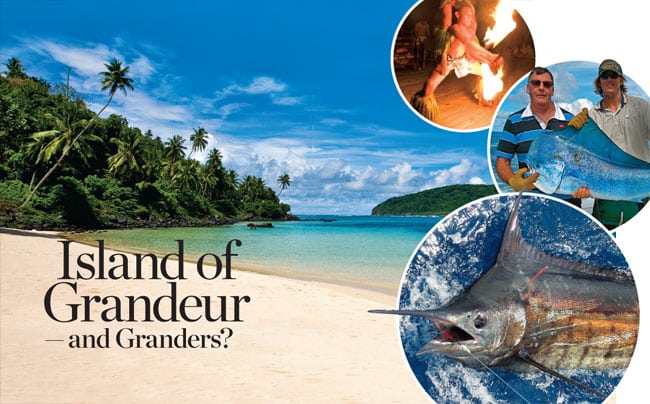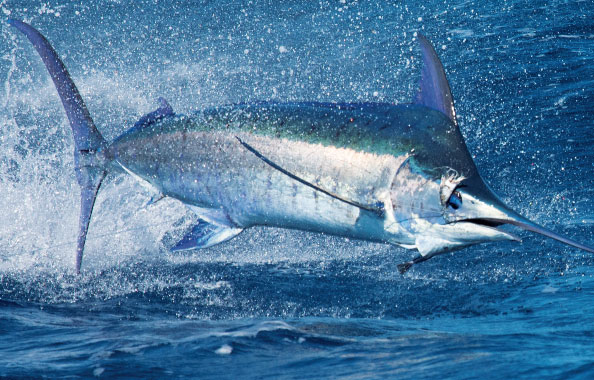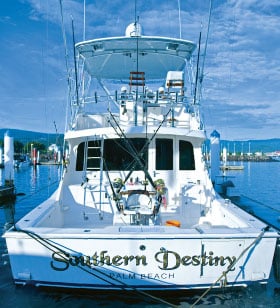
I grew up surrounded by cold-water fish and could not understand the draw of the deep ocean, until I was given a book called Pacific Blue by Steve Lomas. The story depicts a young boy who has a passion for fishing. He desires nothing but to fish in a marlin tournament and win. As such stories often go, he is given his chance and comes out victorious. I read this book over and over again for several years straight and would dream nightly of one day being able to fish (and win) a marlin tournament. As the former marketing manager for Shimano and the host of a television show, I’ve spent plenty of time fishing for marlin in the Atlantic, the Gulf of Mexico and the Pacific, but until recently, I had never fished in the Far East or in a marlin tournament.
I saw a post on Facebook one afternoon by Capt. Chris Donato, a friend I hadn’t seen since we had deep-dropped for broadbills together out of Florida many years earlier. His post stated that he needed an angler to fish the 2012 Samoa International Game Fishing Association (SIGFA) marlin tournament, which was three weeks away. The opportunity had presented itself. I immediately posted a reply expressing my sincere interest. I was given dates of arrival and departure, and the trip was booked. Luckily, I was able to schedule the trip so that I could spend a few days fishing and exploring before the tournament.
But what was I getting myself into? Samoa? That’s not where I had envisioned my days of grandeur winning a billfish tournament. Kona, East Cape, Panama, the Great Barrier Reef, Costa Rica — those places are where the best marlin fishing in the world is. Right?

A Short History
Capt. Chris Donato has a passion for fishing, but surfing stole his heart first. As Donato traveled the world in search of the perfect barrel, he landed on the small island of Samoa and found his Graceland. After several years, Donato managed to find business partners and purchased a surfing resort on the south side of Samoa called Salani Surf Resort. He had accomplished and experienced more before age 30 than most people do in a lifetime. But it wasn’t enough. His desire to fish began to take over, and he brought an Ocean Master center-console boat to Samoa to explore the water surrounding his new home.
Right away, he found hordes of fish! Off the shallow breaks were massive giant trevallies and dogtooth tuna that couldn’t be turned. As he moved farther out, he found big yellowfin tuna, wahoo, dolphin, sailfish and striped marlin. Blues were always in the mix, but he never could land the big bite. Donato’s competitive spirit kicked into overdrive. He sold the center console and bought a Cabo 43 in Palm Beach, Florida, aptly naming it Southern Destiny. Almost immediately, Donato shipped the Cabo through the Panama Canal to California, where it was put onto a container ship destined for Samoa. Southern Destiny arrived in Samoa and was immediately outfitted with 80s and 130s. Chris had lost his last big fish due to lack of proper equipment. No more excuses.
Since it was the first boat of its kind in the area, Southern Destiny, and Capt. Donato’s services and equipment, soon came into high demand by anglers in the surrounding islands. Donato fished the boat around Fiji, Wallis, Futuna and, finally, Vanuatu, where he stayed for a year running charter trips. But Samoa continued to draw him back, and once back, he fished the ledges of his home island. When fishing in a new place, the learning curve is steep during the first few months behind the controls. No fish aggregating devices exist off the shores of Samoa, so Donato turned to the only structure readily available: the steep ledges that surround the island.
Trolling lures is the primary tactic used there, and not only because of blues’ aggressive nature; a lack of consistent, high-quality bait also means more time is spent on the troll. Trolling lures also afforded Donato the opportunity to cover hundreds of miles of water rapidly, and he began to pattern the marlin he sought. However, diesel is, not surprisingly, incredibly expensive in Samoa, and since the area is not (yet) known as a marlin-fishing destination, charters were few and far between. Something would have to happen quickly or Donato would run out of cash.

The Grander
After several months of inconsistent charter trips, Southern Destiny got the opportunity to fish seven straight days in November 2011. During those seven days, Donato guided his charter to multiple marlin raises and catches — including 500- and 800-pound blues on consecutive days. Impressive by any account, but not as impressive as what occurred on the charter’s last day.
Donato left Apia Harbor midmorning with his brand-new deckhand, Pelenato, who had never wired a marlin, and his good friend, Sal, who had never caught one. Seven miles offshore, the big bite Donato had dreamed about for so many years crushed the Black Bart Blue Breakfast on the left short. They battled the fish for several hours as it leaped completely out of the water on multiple occasions and then dove for the bottom. After what seemed like an eternity, the big blue came up from the deep with no life left in her. The three-man team tried to manhandle the beast through the transom door, and even turned to the windlass at one point to bring it on deck, but they couldn’t get her in the boat. They ended up lashing the great fish to the stern of the boat, and Southern Destiny inched its way home.
The scales in Apia Harbor were insufficient to weigh their catch, so the team found a crane, which they used to put the marlin on a truck so it could be driven to a certified scale. All three of the exhausted men watched as the big blue was hoisted aloft and the numbers began to climb. The wench hesitated under the weight, and with the head of the marlin still on the ground, the scale read 980. The scale strained as it lifted the blue up into the air. One last quick glance, and the scale read 466 kilograms — 1,025 pounds! Samoa’s first grander had been caught!

The Waters of Samoa
Donato believes that Samoa has incredible potential to be the next blue-marlin capital of the world. “We have seen blue marlin in excess of 600 pounds every month out of the year,” he says.
Donato and a number of Samoan captains have, on a regular basis, seen fish even bigger than the granders they’ve caught. “The reason why no one hears about the incredible marlin fishing in Samoa is because it’s an untapped fishery,” he says.
Southern Destiny and only one other boat charter these waters. “Most of these charters are run by inexperienced anglers who simply want to catch a fish, whether it’s a big blue or not.” This relegates the majority of charter trips to fishing nearshore in search of dolphin and wahoo. “There are areas off Savaii and the south side of Samoa that look absolutely incredible on the chart that I would love to fish, but just have not had the hard-core marlin angler available to go try it,” Donato says.
The 1,000-fathom curve is a mere 10 miles from shore on the north side of the island and only four miles from shore along the south banks. “Samoa is very similar to Hawaii in its bottom structure,” he says. “Contour lines here run very tight in several places, with one side dropping off 2,500 feet and the other dropping off 6,500 feet immediately.” Donato likes to target deep drops, especially during tide changes.
The “marlin highway,” Donato says, runs just out of the port and flows from east to west. When he’s not fishing the ledges, he likes to focus in on this line of current and look for birds or schools of tuna actively feeding on the surface.

Donato theorizes that the waters off Samoa are a blue-marlin spawning area. “With massive schools of skipjacks, no predators, and warm, calm water, this is an ideal location for marlin to congregate and spawn,” he says. “We’ll be surrounded by smaller males all day, and then we’ll get a huge crash bite from a big one.”
Marlin fishing is good year-round here, with the October-to-January window being the best time. “Typically, we get two to four shots a day year-round,” Donato says. “During November and December, an average day raises 10 to 12 blues into the spread, with most fish in the 300-pound class.” Although these months offer the biggest numbers of marlin, Donato loves catching blues from May to September. “For some reason, possibly the higher water temps or massive schools of aku (skipjack tuna), the fish that time of year are bionic, and you can’t break their spirits! It’s not uncommon to have to put in excess of 40 pounds of drag on a medium-size blue marlin just to get it to calm down, and it’s always a show on the wire!”
Although Donato live-baits with skipjack and small yellowfin tuna, or runs chuggers with ballyhoo, most days are spent trolling a five-lure spread off the riggers. “These fish are just not pressured by anglers and are very aggressive,” he says. Southern Destiny is designed for targeting big blues. That alone is what Donato would like to do. He hopes to one day have consistent charters with skilled anglers to explore the virgin waters of Samoa year-round in search of granders.







